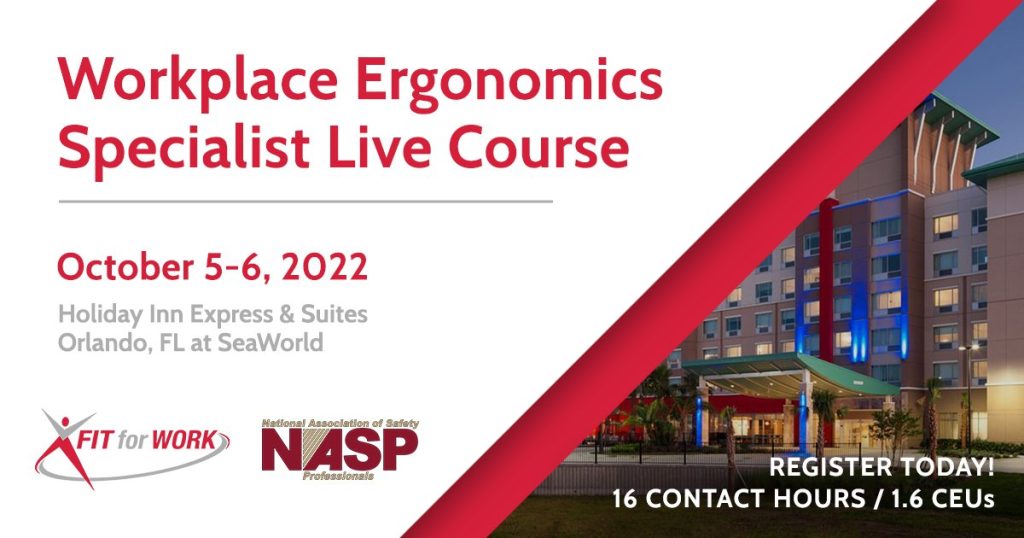By Lauren Brizendine, MPH, CPE
Director of Ergonomics, Fit For Work
It’s no secret that ergonomic risks are ever-present in the workplace, but the process of identifying and mitigating those risks can seem far less straightforward for many business owners.
Thankfully, there are several industry-standard ergonomic assessment tools safety professionals can leverage to apply specific values to the unique risks of a job. These values can then be used to help justify and support the investment toward ergonomic solutions.
Here is a closer look at some of the most common ergonomic assessment tools in the industry today, along with how and when to use each to improve safety and reduce injuries within your working environment.
Remember: Some situations may require more than one of these tools, or potentially a tool customized for the situation.
Rapid Entire Body Assessment (REBA)
This highly illustrative and visual tool was developed to help quickly assess any posture-related musculoskeletal risks tied to various activities in the workplace.
Within a REBA, point values are determined for each body segment based on:
- Observed posture
- Load force
- Coupling
- Duration
These points are then added up to generate a total score for the task, with a lower score equating to a lower level of risk.
When to Use REBA
A Rapid Entire Body Assessment is most effective when looking to assess the upper and lower extremities for a task that does not involve much lifting or exerting heavy forces.
Rapid Upper Limb Assessment (RULA)
The RULA is another visual tool that aims to quickly assess the working population’s risk of upper extremity disorders.
Similar to the REBA, point values are determined for each body segment based on:
- Observed posture
- Load force
- Duration
These point values are then totaled to pinpoint the overall risk of a task.
When to Use RULA
RULA is ideal for assessing the risk of upper extremity disorders in primarily sedentary job processes that do not involve much lifting or exerting heavy forces.
Revised NIOSH Lifting Equation (RNLE)
The RNLE is slightly unique in this space, as it was created to assess musculoskeletal risk specific to the lower back during the design of workstations and work processes. Still, it can be used to help determine the relative risk of lower-back injuries associated with lifting.
The RNLE is structured as an equation that provides you with a recommended weight limit (RWL) and a lifting index (LI) to inform injury risk. The RWL is the maximum acceptable weight nearly all healthy employees can lift over an eight-hour shift without increasing their risk of injury, while the LI is the product of all the information analyzed.
If the LI is less than 1, it means there’s a minimal risk of injury. As it moves higher, so does the risk of injury. An LI greater than 3 means the task has been clearly linked to an increased risk of lower-back injury.
One need-to-know limitation of the RNLE is that it was not designed for one-handed lifting or for lifting while seated or kneeling.
When to Use RNLE
The RNLE is best used when assessing risks during the design or redesign of workstations or processes. It is also often used to determine the relative risk of lower-back injury associated with any lifting task where manual material handling duties other than lifting (such as walking or carrying) account for less than 10% of the total worker activity.
Liberty Mutual Manual Material Handling (LMMMH) Tables
LMMMH Tables – also known as Snook & Ciriello Tables – were created to help design work processes based on the percentages of the male/female population capable of safely performing manual material handling (MMH) tasks.
The industry standard is that MMH tasks should be designed to be safely performed by greater than 75% of the female population.
These tables provide scenarios combining weights/forces with:
- Hand placement
- Frequency
- Duration
- Origin/Destination
Based on these combinations, the population percentages able to safely perform the MMH tasks are determined.
The primary limitation of the LMMMH Tables is that additional tools are required for data collection, such as a force gauge.
When to Use LMMMH Tables
These tables are ideally suited for designing or redesigning manual material handling tasks in a manner that allows the greatest number of workers to perform the tasks. If asked if an object is too heavy to lift or too hard to push or pull, the appropriate equipment can help determine the percentage of the population that can safely perform the task, in addition to helping you present your findings to the right people.
The Ohio BWC Push/Pull Guidelines are similar to the LMMMH Tables in that they involve using a force gauge to measure the maximum force (pushing or pulling) needed in a given task. You then record the height of the hands (i.e., where the worker’s hands would normally be on the handle) and use both values to determine the guidelines for the task. Where the two assessments primarily differ, however, is the fact that LMMMH Tables were created based on psychophysical information (subjective, self-reported data) while the Ohio BWC Push/Pull Guidelines were developed based on biomechanical modeling (objective and quantitative data).
Moore-Garg Strain Index
The Moore-Garg Strain Index is used to calculate the risk of developing a musculoskeletal disorder (MSD) while conducting hand-intensive work. The process involves dividing a job into tasks and then assessing the following six job risk factors for each task and for each hand:
- Intensity of exertion
- Duration of exertion
- Efforts per minute
- Hand/wrist posture
- Speed of work
- Duration of task per day
When to Use Moore-Garg Strain Index
The Strain Index is appropriate to use when you need to evaluate the risks of hand-intensive tasks and is thus commonly used to assess many small assembly tasks.
About Fit For Work
Safety in the workplace is an evolving necessity — and it’s now about so much more than instructional videos and first aid training. It’s about getting ahead of injuries before they happen by cultivating a proactive, results-driven safety program focused on preventing your employees from becoming patients.
Fit For Work achieves this by providing employers at more than 1,750 locations across the country with strategic, consistent support to ensure their workers can experience a safer, happier, and more productive professional life. From onsite early intervention and ergonomics to safety compliance and employee testing, our services are designed to help safety managers and specialists prevent injuries while creating a more productive environment for their workers.





